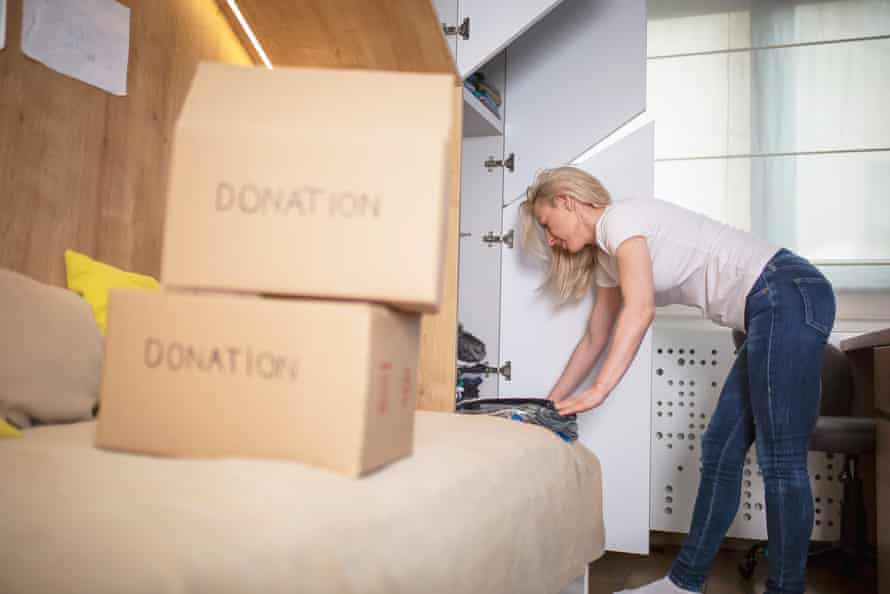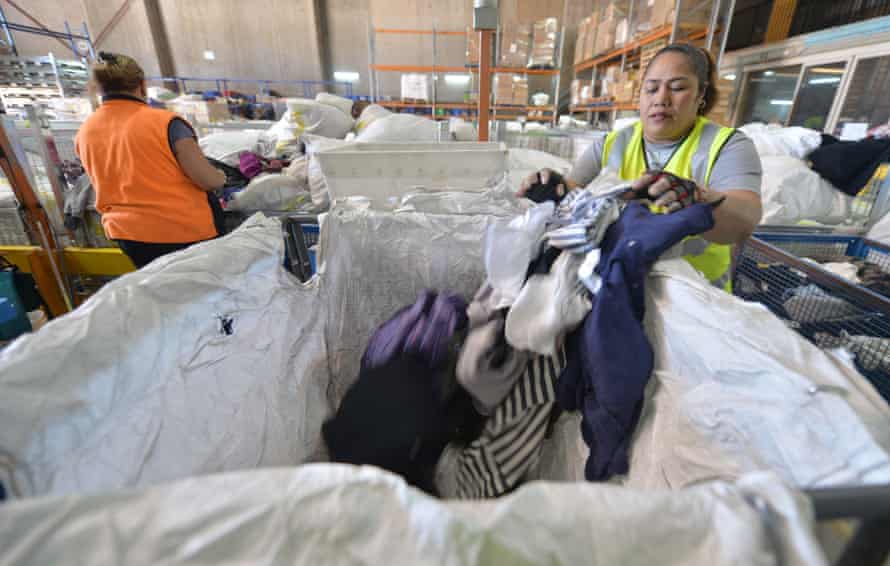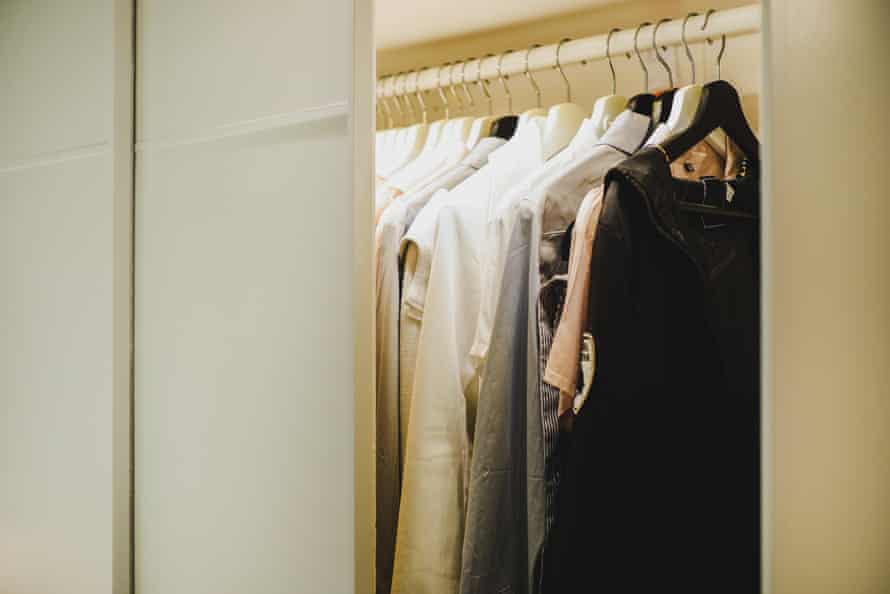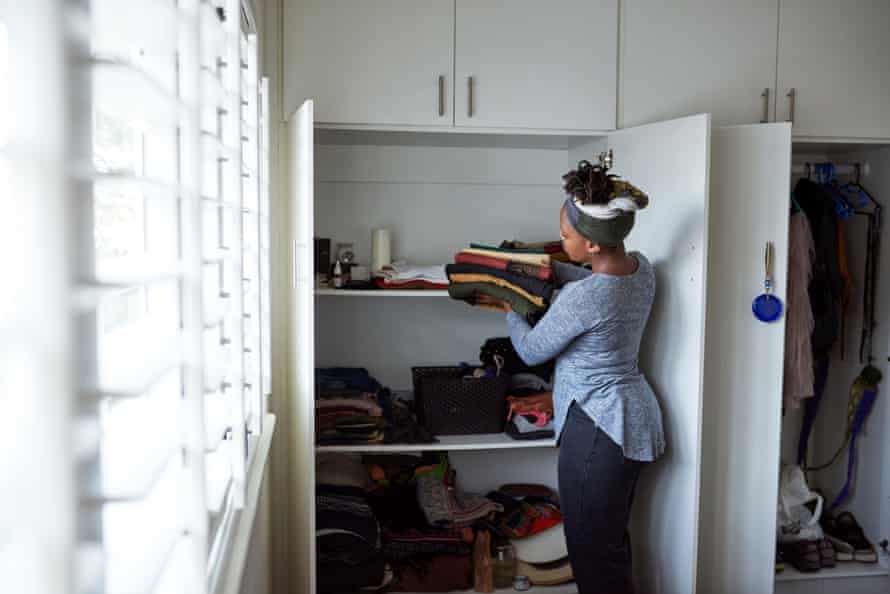An Australian guide to cleaning out your wardrobe: recycling clothes without sending them to landfill

Australia has a textile waste problem – but there are simple solutions to avoid contributing to it
There are several large clothing donation bins around the corner from my apartment. One morning I had to wait behind a truck that had stopped beside them. I watched as two men in bright orange vests hauled white garbage bags full of clothes into the back of it. The truck’s square, steel jaws opened to reveal even more piles of bags.
After the year we’ve experienced, enduring weeks and months at home, the desire to purge via closet cleansing seems universal. It has been documented in the Wall Street Journal and the Washington Post, while a writer from Vogue has turned livestreamed discussions about unworn items into an Instagram hit.
Every 10 minutes, about 6,000kg of textiles are dumped in landfill in Australia. On 26 May, the federal minister for the environment, Sussan Ley, hosted a clothing and textile waste roundtable with participants from across the fashion industry who agreed a circular economy, in which textiles are reused then recycled, is critical to combat the issue.
An essential part of a circular textile economy is a system to collect and sort used clothes. This may sound simple, but given the sheer volume of textile waste, it requires large-scale infrastructure and technology.
Textile recycling is complicated. Natural fibres require different processes to synthetics, and blended fibres are even harder to recycle. While technological solutions may come in the future, currently in Australia, most sortation is done manually – which means physically checking each garment’s care label.
In good news, cotton growers are experimenting with putting shredded cotton back on to new crops, and an Australian startup called BlockTexx recently secured $5.5m in funding to build its first large-scale recycling facility in Logan, Queensland.
Blocktexx founder Adrian Jones says “there is a need for policy intervention” to organise and manage textile waste. In its absence, the decisions we make about what to do with our old clothes are important. Let’s start with the piles we divide them into on our bedroom floors: donate, sell, throw out, keep.
Donate
The rule for donating used clothing is: would you be proud to gift it to a family member or a friend? If the answer is no, then you need another solution. According to an impact study from Charitable Recycling Australia, 16.5% of the textiles donated are resold in charity shops, 33% of the goods are exported for reuse overseas and 36% are downcycled.

Despite media reports that the sector is suffering under the amount of clothes being dumped, Omer Soker, the CEO of National Association of Charitable Recycling Organisations, says they “have the capacity for lots more”.
It is important to wash your old clothes before donating them, and to separate out any items with missing buttons, broken zippers or stains.
Sell

According to the ThredUp 2021 Resale Report, the secondhand clothing market is projected to double in the next five years. Gen Z have commandeered apps such as Depop and TikTok to sell clothes. Old-school platforms such as eBay and Facebook Marketplace are still thriving despite the rise of online consignment stores like Vestiaire, The RealReal and most recently in Australia, Poshmark.
Designers who are keen to embrace circularity and capitalise on the extended life of their garments are working with these resellers. The RealReal has partnered with Stella McCartney, Burberry and Gucci, while Vestiaire has collaborated with the Alexander McQueen label.
Locally, Arnsdorf ran a take-back program in March, and Kitx will launch an exchange program in August. Both programs encourage customers to exchange preloved items for vouchers.
Programs such as the Clothing Exchange facilitate large-scale clothing swaps, which can be mirrored among friends, or better yet, admired items can be gifted to loved ones in the post.
Throw out
Although it can be tempting to declutter by simply throwing odd socks, T-shirts and torn jeans in the bin, the rubbish is the last place textile waste should go. Even natural fibres will take a long time to biodegrade in landfill, and synthetics may never break down.
A council study from Victoria found textiles make up 3% of household waste, which is about the same as other waste categories that have dedicated recycling streams such as plastic, glass, aluminium and steel.
Until this changes, Soker says charities are happy to accept more donations of textile garments, because they have the infrastructure and capacity to ensure garments correctly sorted, resold, or downcycled into rags.

It helps if unusable garments are separately bagged and labelled. Old T-shirts and jeans can also be cut up and used for household cleaning.
Another alternative to throwing out unusable garments are companies such as Upparel, which collect unwanted clothes for a small fee and sort them for you. Fast-fashion retailers like H&M and Zara often have clothing bins at their stores too.
Keep

The first items to go in the keep pile are the things we wear once or twice a week. These garments offer us clues that can help make us be better, more sustainable shoppers.
Using the clothes we already own is the fastest way to a sustainable fashion industry, and understanding our habits better can stop us from buying clothes we won’t actually wear. Beside my keep pile, there is a subcategory of clothes that need alterations or repairs.
Orsola DeCastro, the founder of Fashion Revolution, advocates for keeping, mending and wearing our clothes in her book, Loved Clothes Last. If (like me) you don’t know how to repair them yourself, she advocates using local repair shops, dressmakers and tailors who have the skills to mend and alter things. In doing so, we are helping sustain an industry and their skills. Similarly, professional steaming or pressing can give garments new life.
Love
In my closet, there is a growing collection of clothes I will never wear again but can’t bear to part with. I recently decided I would store them for my one-year-old niece. Maybe the orange cashmere coat I bought on my first trip to Milan will end up in her dress-up box, or maybe she’ll wear my black silk chiffon jumpsuit to her formal. Either way, these pieces offer me (and her) a time capsule to the more beautiful parts of my youth.

It’s worth considering what it is about these garments that elicits an emotional reaction and trying to keep that quality in mind every time we go to purchase something new.
Is the item in your hands something you will want to pass on to someone you love? Something that makes you feel like a better version of yourself? Something that you’re proud to bring into your home?
Maybe this is a high bar to set, but given how complicated it is to safely dispose of clothes – and their high environmental price tag – it’s a bar very few items should clear.